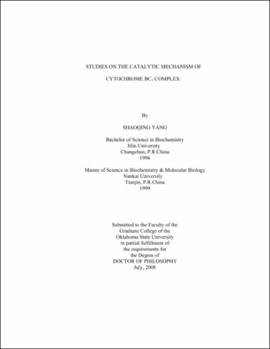| dc.contributor.advisor | Yu, Chang-An | |
| dc.contributor.author | Yang, Shaoqing | |
| dc.date.accessioned | 2013-11-26T08:23:00Z | |
| dc.date.available | 2013-11-26T08:23:00Z | |
| dc.date.issued | 2008-07 | |
| dc.identifier.uri | https://hdl.handle.net/11244/6683 | |
| dc.description.abstract | Scope and Method of Study: The purpose of this study is to further investigate the catalytic mechanism of cytochrome bc1 complexes. With site-directed mutagenesis, we constructed a series of mutant cytochrome bc1 complexes, such as mutants lacking heme bL and bH, mutant in which ISP is fixed at c1-position by engineered inter-subunit disulfide bond, and mutants whose mutations are located in the ef loop of subunit cytochrome b. I have investigated mutant complexes' biochemical and biophysical properties with EPR, stopflow, spectrophotometer, and so on. | |
| dc.description.abstract | Findings and Conclusions: In mutant H198N of cytochrome b, no heme bL is formed. Likewise, in mutant H111N, no heme bH is formed. The loss of either heme bL or heme bH will significantly decrease cytochrome c and c1's reduction rates. However, in the mutant H111N, heme bL reduction rate is pretty close to that of wild type bc1. Since heme bL cannot be reduced unless ISP took one electron from QH2, we can conclude that ISP reduction rate in H111N is also close to that of wild type bc1. As a consequence, we can conclude that ISP movement is controlled by the electron transfer in low potential chain. Meanwhile, fast kinetics studies show that antimycin can affect QH2 oxidation at QP Pocket. EPR spectra from these two mutants doesn't show the presence of antimycin-resistant radical signal, indicating QH2 oxidation maybe follows concerted mechanism. Proteinase K digested cytochrome bc1 increases superoxide production, indicating proteinous component in cytochrome bc1 is not required for superoxide production. Further investigation shows that hydrophobic environment and high potential oxidant are required for superoxide production by QH2. Purified Mutant protein S141C(ISP)/G180C(cyt. c1) shows very little catalytic activities. However, after treated with ?-mecaptoethanol, its activities can be recovered up to 80% of that of wild type bc1. Electron transfer rate between ISP and cytochrome c1 in this mutant is 100 times faster than that in wild type bc1, further indicating ISP head domain is fixed at c1-position in this mutant. Two important residues (I192, L286 in the ef loop of R.S. cytochrome bc1 were identified through alanine scanning. Analysis of catalytic activities indicated their bulky side chain plays a role during catalysis. Further investigation is needed. | |
| dc.format | application/pdf | |
| dc.language | en_US | |
| dc.rights | Copyright is held by the author who has granted the Oklahoma State University Library the non-exclusive right to share this material in its institutional repository. Contact Digital Library Services at lib-dls@okstate.edu or 405-744-9161 for the permission policy on the use, reproduction or distribution of this material. | |
| dc.title | Studies on the catalytic mechanism of cytochrome bc1 complex | |
| dc.contributor.committeeMember | Yu, Linda | |
| dc.contributor.committeeMember | Burnap, Robert Lord | |
| dc.contributor.committeeMember | Matts, Robert L. | |
| dc.contributor.committeeMember | Massiah, Michael | |
| osu.filename | Yang_okstate_0664D_10573.pdf | |
| osu.accesstype | Open Access | |
| dc.type.genre | Dissertation | |
| dc.type.material | Text | |
| thesis.degree.discipline | Biochemistry and Molecular Biology | |
| thesis.degree.grantor | Oklahoma State University | |
